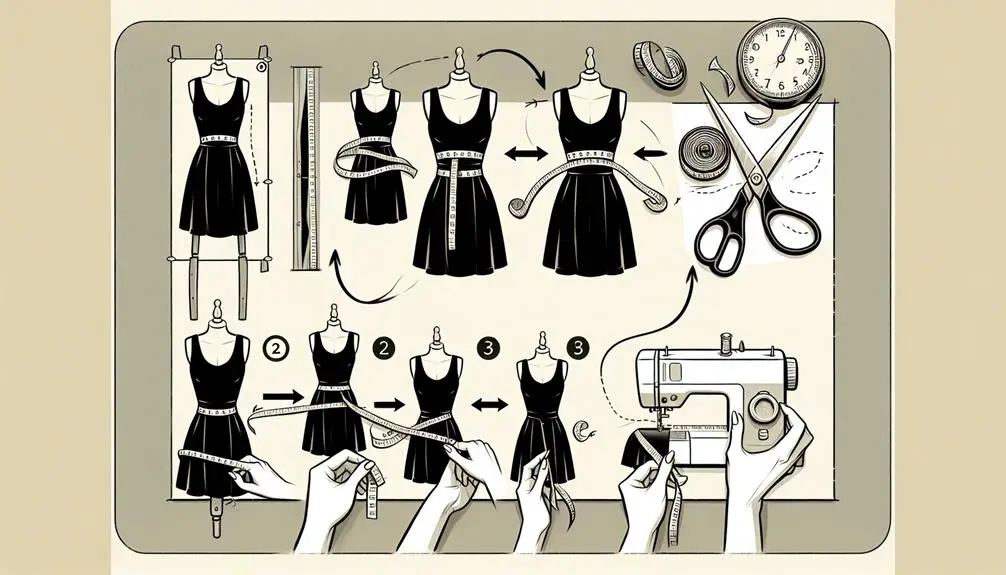As someone who enjoys fashion, I was surprised to learn that over 60% of women have at least one dress in their closet that they wish was shorter.
Making a dress shorter can be a simple yet transformative process that can give new life to an old favorite. Whether you want to revamp a thrifted find or tailor a dress to your liking, understanding the basics of altering the length can open up a world of possibilities for your wardrobe.
Let me walk you through the steps to achieve the perfect hem without compromising style or fit.
Table of Contents
Key Takeaways
- Measure accurately and cut along marked line for a new hem.
- Secure the hem with a straight stitch for a professional finish.
- Use sharp scissors and press the hem for a polished look.
- Double-check adjustments and measurements for a perfect fit.
Identifying the New Hem
When shortening a dress, I start by using a similar garment as a guide to identify the new hemline length accurately. This guarantees that the final length will be just right. I meticulously measure and mark the new hemline using a measuring tape, making sure it's even all around. To allow for a seam allowance, I measure an additional 1 inch (2.5cm) below the marked line. Carefully using fabric scissors, I cut along the marked line, ensuring a clean and straight edge.
Once the excess fabric is trimmed off, I secure the new hem in place with a straight stitch. This stitch not only keeps the hemline in position but also provides a professional finish to the shortened dress. By following these precise steps, I can confidently alter the length of the dress while maintaining its original shape and style.
Creating the New Hem
To establish the new hem on a dress, accurately measure the desired length using a measuring tape for precision. Once the measurement is taken, it's time to create the new hemline. Here are some key steps to follow for a successful outcome:
- Precision is Key: Ensuring accurate measurements is critical for a professional finish. Take your time to measure and mark the new hemline correctly.
- Sharp Cuts for Clean Edges: Use sharp fabric scissors to cut along the marked line. This will help prevent fraying and ensure a neat edge that enhances the overall look of the dress.
- Secure and Sew: After cutting, fold the fabric under to the desired length, pin it securely in place, and sew around the edges. This step not only secures the new hem but also adds a polished touch to the shortened dress.
Mastering these techniques will help you confidently shorten the hem of any dress with precision and finesse.
Getting the Best Results
I always make sure to measure the dress length accurately and use sharp scissors for a clean cut.
Pinning the new hemline in place and using coordinating thread with a narrow zigzag stitch are essential steps for a professional finish.
Pressing the hem with an iron afterwards guarantees a polished look, and double-checking all adjustments guarantees a perfect fit.
Measure Dress Length
How can you *guarantee* the accuracy and precision of your dress length measurement?
To make sure the correct length when shortening your dress, follow these key steps:
- Measure Length: Utilize a measuring tape for precise measurements.
- Mark the New Hemline: Use a fabric marker or chalk to clearly indicate the desired length.
- Consider Seam Allowance: Allow an extra inch for seam allowance when marking the new hem.
Taking accurate measurements and marking the dress correctly are essential in the cutting process to achieve the desired dress length. Double-checking the measurements before cutting will help avoid any errors and ensure a successful alteration.
Use Sharp Scissors
Using sharp fabric scissors is essential for achieving clean and precise cuts when shortening a dress. Sharp blades guarantee you get crisp edges and a clean hem, elevating the overall look of your garment.
High-quality scissors make fabric alterations more manageable, allowing you to cut through various fabric types effortlessly. Dull scissors can lead to uneven edges and fraying, compromising the final result.
To maintain cutting efficiency, it's critical to regularly sharpen or replace your fabric scissors. Investing in a good pair of fabric scissors is a wise choice for anyone looking to achieve accurate and professional-looking dress alterations.
Expert Q&A
I'll be addressing some key points concerning length adjustment techniques and styling tips in this Expert Q&A section.
These insights will help you understand how to tailor the length of a dress to suit your preferences and occasions better.
Let's explore the best practices for achieving a flawless and professional finish when shortening a dress.
Length Adjustment Techniques
To master the art of altering a dress's length, one must grasp the essential techniques for achieving a flawless adjustment. When shortening a dress, precision is key. Here are some critical steps to guarantee a perfect fit:
- Accurately measure the desired length to avoid any mistakes in the alteration process.
- Pin the hem in place securely before using a sewing machine to secure the new hemline.
- Iron the hem for a polished and professional finish.
Styling Tips
When it comes to styling tips for shortening a dress, considering the occasion, body type, and height plays a significant role in determining the ideal length.
Using a measuring tape accurately guarantees the desired dress length.
To shorten your dress, mark the new hemline with a chalk line, then secure the fabric in place with pins.
For delicate fabrics, using gentle techniques like hand-sewing or fabric glue is recommended.
If you want to maintain the original hem, carefully remove excess fabric above the marked line.
These methods, whether using a sewing machine or hand-sewing, help achieve a tailored look that complements your body shape and the event you're attending.
Tips
Consider enlisting a friend's help for precise measurements and correct placement when hemming the dress for the best results. When tackling the task of shortening a dress, a few tips can make the process smoother:
- Using chalk: Mark the desired length with chalk before cutting to guarantee accuracy and avoid mistakes.
- Trimming excess fabric: Be cautious when cutting the excess fabric, as it's easier to shorten the dress further than to add fabric back.
- Carefully handling multiple layers: If the dress has multiple layers, make sure to adjust each layer uniformly to maintain a cohesive look.
These tips are essential for achieving a well-fitted and professionally shortened dress. By following these guidelines, you can confidently alter the dress length while maintaining its integrity. Remember to proceed with caution and precision, using a pair of scissors and fabric glue when necessary to secure the hem.
Reader Success Stories
Some readers have shared their successful experiences in shortening dresses using step-by-step instructions. When shortening a dress, it's important to think about the types of fabrics you're working with. Using appropriate tools like fabric tape, fabric glue, or safety pins can help achieve clean hems on delicate fabrics.
In my recent project, I used chalk to mark the desired length before cutting the excess fabric. It's critical to measure the length accurately to guarantee a precise outcome. Additionally, enlisting the help of a friend can make the process smoother and help in achieving professional results.
I found that by pressing the hem with an iron after sewing, the dress looked neat and well-finished. Trying out new techniques and being meticulous in each step can lead to successful dress shortening projects. Make sure to follow the instructions carefully to avoid any mistakes and enjoy the satisfaction of creating a perfectly shortened dress.
Measuring And Marking Up Your Dress
In my recent project of shortening a dress, the initial step involved measuring and marking up the fabric to achieve the desired length. It's important to measure twice to make sure accuracy before cutting the fabric.
Using fabric chalk to mark the new hemline allows for precise adjustments, making sure a perfect fit. Additionally, pins can be used to mark the fabric temporarily before sewing to avoid any mistakes.
- Measure Twice: Precision is key when shortening a dress to guarantee the final length is exactly as desired.
- Use Fabric Chalk to Mark: This tool provides clear markings on the fabric for accurate cutting and sewing.
- Pins to Mark: Utilizing pins helps in securing the fabric in place while making adjustments for the new hemline.
7 Simple Ways To Shorten A Dress
To shorten a dress effectively, accurately measure the desired new length using a measuring tape for precision. Making sure to mark the new hemline accurately is important.
I use the measuring tape as a guide and add an extra inch for seam allowance before cutting with fabric scissors. When cutting, I pay close attention to make a straight line.
After shortening the dress, I fold the fabric under, pin it securely in place, and sew around the edges to prevent fraying of the raw edges. This folding technique helps create a clean finish.
Frequently Asked Questions
How Can I Make My Dress Shorter Without Cutting It?
To make my dress shorter without cutting it, I can explore temporary options like using hemming tape, fabric glue, waist belts, knotting the skirt, or creatively folding and tucking the fabric. Ruffled or layered designs offer adjustable lengths for versatility.
How Do I Shorten a Dress?
To shorten a dress, accurately measure, mark, and cut the new hemline. Then fold, pin, and sew the fabric securely. Press with an iron for a polished look. These steps guarantee a perfectly tailored dress.
How Do You Make a Dress Smaller Without Sewing?
To make a dress smaller without sewing, I employ clever styling tricks like using fabric tape, safety pins, or a waist belt lift. Knotting excess fabric at the waist or folding/tucking creatively are handy non-sewing solutions.
How Do You Lengthen a Dress That Is Too Short?
To lengthen a dress that is too short, accurately measure the needed additional length, choose matching fabric, carefully seam rip the hem, sew on the new fabric, and press the hem for a polished look.
- Does Chiffon Fabric Stink - July 15, 2025
- Does Chiffon Fabric Affect the Economy - July 15, 2025
- Does Cotton Fabric Have a Nap - July 15, 2025






